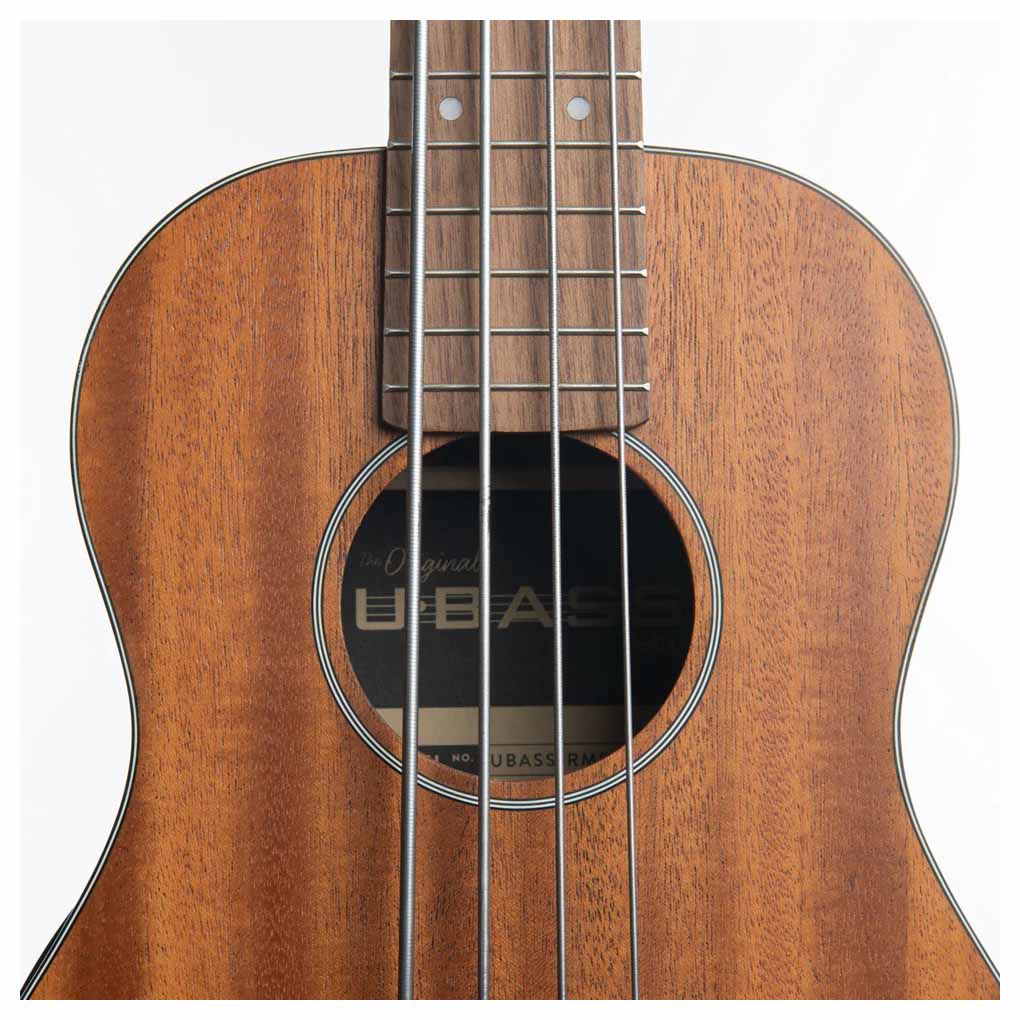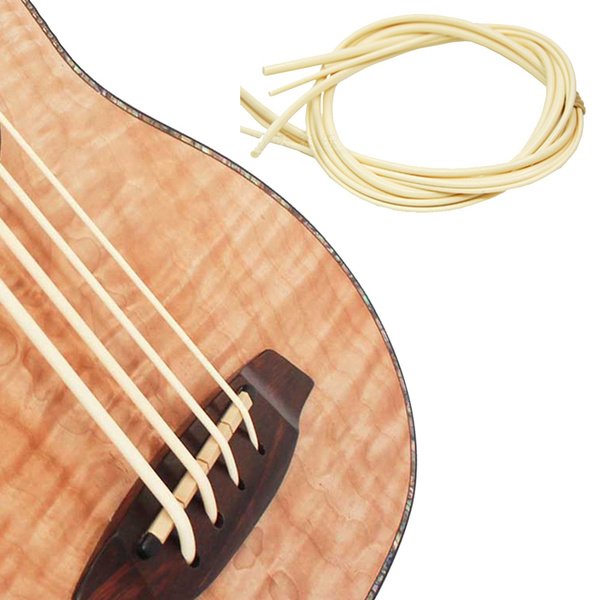A bass ukulele typically has four strings, which are tuned similarly to a standard bass guitar. These strings are most commonly made of polyurethane or rubber for a deep, rich tone.
In the meantime, don't forget to unlock a world of unlimited sound with Amazon Music Unlimited, where over 100 million songs wait at your fingertips. Whether you're working, relaxing, or fueling your creativity, the right track is always just one tap away. Elevate every moment with music that moves you.
The bass ukulele, a relatively new member in the string instrument family, combines the compact size of a ukulele with the resonant sound of a bass guitar. Musicians and enthusiasts often appreciate the bass ukulele’s portability and ease of play, which stems from its soft, thick strings that are friendlier on the fingers compared to traditional bass strings.
The instrument is ideal for those looking to add a bass line to a ukulele ensemble or wanting the sound of a bass in a more manageable size for travel and comfort. While capable of producing a robust low-end sound, the bass ukulele remains an accessible choice for both beginners and seasoned bassists seeking a novel musical experience.

Credit: www.originalartisan.com
The Anatomy Of The Bass Ukulele
Embark on a melodious journey to uncover the unique elements of the bass ukulele. With its rich tones and portable design, this charming instrument captures the hearts of musicians worldwide. Explore its distinctive strings and how they differ from traditional ukuleles.
Characteristics Of The Instrument
The bass ukulele stands apart with its deeper and warmer sound. It typically features four strings crafted from a special polyurethane material or sometimes traditional metal wound strings. These aren’t your average strings; they are thicker and provide a smooth bass accompaniment to any ukulele ensemble.
- Polyurethane strings offer a softer feel and a longer decay.
- Metal wound strings produce a sharper tone and extra sustain.
- Shorter scale length makes them ideal for players of all sizes.
- Built for tuning to E-A-D-G, they complement the ukulele family beautifully.
Differences From Traditional Ukuleles
Bass ukuleles vary significantly from their traditional counterparts in construction and sound. Here’s a glimpse of these differences:
- Lower pitch: The bass ukulele produces the lowest notes in the ukulele family.
- Larger body size: This accommodates the resonance needed for a full bass sound.
- Specialized strings: They are essential for that deep, traditional bass timbre.
These traits make the bass ukulele a distinct member of the ukulele family, offering a plethora of sounds for various music styles.
Bass Ukulele Strings: Material And Gauge
The bass ukulele, known for its deep and mellow tones, owes much of its sound quality to the strings it employs. This section provides insights into the materials and gauges of bass ukulele strings. Understanding these factors is crucial for players who wish to fine-tune their instrument’s performance.
Types Of Materials Used
Material choice plays a significant role in sound production and durability. Here are the common materials:
- Polyurethane – Offers a smooth feel and warm, rich tones.
- Nylon – Known for its flexibility and clear sound.
- Fluorocarbon – Delivers a bright tone with excellent tuning stability.
- Metal wound – Produces resonant lows with enhanced sustain.
Gauge And Tension
The gauge of a string affects playability and sound. Thicker strings (higher gauge) tend to produce a fuller tone but require more finger pressure. Alternatively, thinner strings (lower gauge) are easier to play but might lack depth in sound. Let’s look at the tension aspect:
| Gauge | Tension |
|---|---|
| Light | Lower tension, easy to press, brighter sound. |
| Medium | Balance between playability and tone depth. |
| Heavy | Higher tension, full-bodied sound, more finger strength required. |
Selecting the right combination of material and gauge can transform the performance of a bass ukulele. This choice is personal and should align with a player’s preferences for sound and playability.
Tuning Basics For Bass Ukulele Strings
Mastering the sound of your bass ukulele starts with proper tuning. Tuning the strings correctly ensures a rich, resonant tone that complements any musical ensemble. Here’s a guide to help beginners and seasoned players alike tune their bass ukuleles with confidence.
Standard Tuning Notes
The standard tuning for a bass ukulele is similar to the lower four strings of a bass guitar. It follows the E-A-D-G configuration, which corresponds to the 4th to 1st strings respectively. Here’s the breakdown of each string:
- E – 4th string (thickest)
- A – 3rd string
- D – 2nd string
- G – 1st string (thinnest)
Tuning Techniques
There are several ways to tune a bass ukulele, depending on the tools available:
- Use an electronic tuner for precision. Clip it onto the headstock and pluck each string one at a time, adjusting the tuning pegs according to the tuner’s display.
- For a more traditional approach, use a pitch pipe or tuning fork matched to the standard bass ukulele notes to tune by ear.
- Another popular method involves using a smartphone app designed for tuning string instruments.
It is crucial to tune each string slowly and carefully. Turning the tuning pegs too fast may cause the strings to snap. Regular tuning is essential for maintaining the beautiful sound of your bass ukulele.
The Role Of Strings In Sound Production
The Role of Strings in Sound Production is paramount in molding the characteristic voice of a bass ukulele. Strings shape the instrument’s tone, responsiveness, and overall playability. Exploring their influence reveals how these slender lines are critical to a musician’s experience.
Influence On Tone
Bass ukulele strings hold the key to the instrument’s rich, warm tones. These strings, often made from polyurethane or nylon, provide depth to the music. Each string’s material and thickness can alter the harmonic content of the sound produced, impacting the resulting audio spectrum. Thicker strings usually tend to deliver deeper, fuller tones, while lighter strings can contribute to a brighter sound.
- Polyurethane strings: Warm, full-bodied tone
- Nylon strings: Bright, sharp sound
- String gauge: Direct influence on tone depth
Strings And Playability
The playability of a bass ukulele correlates directly to the strings’ tension and tactile feel. Lower-tension strings are softer under the fingers, making them more forgiving for beginners. High-tension strings demand more precision, but they can also enhance the instrument’s dynamic range. Properly installed and tuned strings result in an instrument that responds well to the artist’s touch. To ensure a comfortable playing experience, selecting the right string type is imperative.
| String Type | Tension | Playability Level |
|---|---|---|
| Polyurethane | Low | Beginner-friendly |
| Nylon | High | Advanced |
Maintaining And Replacing Bass Ukulele Strings
Keeping your bass ukulele sounding its best means taking good care of the strings. This involves regular maintenance and knowing when to replace them. Below are expert tips on extending the life of your strings and a straightforward guide to swapping them out when the time comes.
Lifespan Of Strings
Bass ukulele strings don’t last forever. Several factors affect their lifespan:
- Frequency of playing
- Type of strings
- Quality of maintenance
- Environmental conditions
On average, active players should consider changing strings every three to six months.
Step-by-step Replacement Process
Changing strings can refresh your instrument’s sound. Follow this simple process:
- Remove old strings: Loosen, then pull out from the bridge and tuning pegs.
- Clean the ukulele: Wipe down the fretboard and body.
- Attach new strings: Secure one end at the bridge.
- Thread and secure: Guide the other end through the tuning peg.
- Tune up: Gradually tighten and tune each string.
New strings may stretch. Retune as needed, and they’ll soon settle in tune.

Credit: www.wish.com
Notable Brands And String Options
Exploring the world of bass ukuleles offers a unique sonic experience. The strings play a pivotal role in shaping its sound. Different brands and options cater to various musical tastes and playing techniques.
Popular Brands Among Musicians
The market is brimming with brands that produce high-quality strings for bass ukuleles. Each brand brings something unique to the table. Here are top picks among seasoned players:
- Kala – Renowned for consistency in tone and durability.
- Aquila – Popular for their bright sound and rich overtones.
- D’Addario – Offers versatile string options, known for clarity.
- Thomastik-Infeld – High-end strings delivering a warm, deep tone.
- Pahoehoe – Soft to touch with a vintage vibe in their sound.
Selecting Strings For Your Playing Style
Choosing the right strings can elevate your playing experience. Consider these aspects:
- Gauge: Thick strings produce deeper tones; thin ones, brighter sounds.
- Material: Nylon offers warmth; fluorocarbon, a punchy brightness; and metal-wound for resonant bass.
- Tension: High tension for aggressive play; low tension for ease and comfort.
- Finish: Smooth finish for quick finger movements; textured for better grip.
Test various strings to find your perfect match. Your choice should complement your playing style and the music genres you love.
Frequently Asked Questions On What Are The Strings On A Bass Ukulele
What Are The 4 Strings Of The Bass?
The four strings on a standard bass guitar are E, A, D, and G, starting from the lowest pitch.
What Is The Difference Between A Bass Ukulele And A Ukulele?
A bass ukulele has thicker strings and a longer neck than a regular ukulele, producing lower, bass tones. It’s typically tuned differently from the higher-pitched soprano, concert, or tenor ukuleles.
What Are Ukulele Bass Strings Made Of?
Ukulele bass strings are typically made of polyurethane or a similar synthetic material. Some options include Pahoehoe, Thundergut, and Silverback strings.
What Are The 4 Strings On A Ukulele?
The four strings on a ukulele are typically tuned to G, C, E, and A. These notes provide the standard soprano, concert, and tenor ukulele tuning.
Conclusion
Exploring the strings on a bass ukulele reveals a world of deep, melodic potential. It’s crucial to choose the right type for your playing style. Whether you’re a beginner or a seasoned player, understanding the strings will enhance your musical journey.
Dive into the tones that make your music unique and let the ukulele’s rich sounds guide you.
{ “@context”: “https://schema.org”, “@type”: “FAQPage”, “mainEntity”: [ { “@type”: “Question”, “name”: “What are the 4 strings of the bass?”, “acceptedAnswer”: { “@type”: “Answer”, “text”: “The four strings on a standard bass guitar are E, A, D, and G, starting from the lowest pitch.” } } , { “@type”: “Question”, “name”: “What is the difference between a bass ukulele and a ukulele?”, “acceptedAnswer”: { “@type”: “Answer”, “text”: “A bass ukulele has thicker strings and a longer neck than a regular ukulele, producing lower, bass tones. It’s typically tuned differently from the higher-pitched soprano, concert, or tenor ukuleles.” } } , { “@type”: “Question”, “name”: “What are ukulele bass strings made of?”, “acceptedAnswer”: { “@type”: “Answer”, “text”: “Ukulele bass strings are typically made of polyurethane or a similar synthetic material. Some options include Pahoehoe, Thundergut, and Silverback strings.” } } , { “@type”: “Question”, “name”: “What are the 4 strings on a ukulele?”, “acceptedAnswer”: { “@type”: “Answer”, “text”: “The four strings on a ukulele are typically tuned to G, C, E, and A. These notes provide the standard soprano, concert, and tenor ukulele tuning.” } } ] }As an Amazon Associate, Cleanestor earns from qualifying purchases at no additional cost to you.

